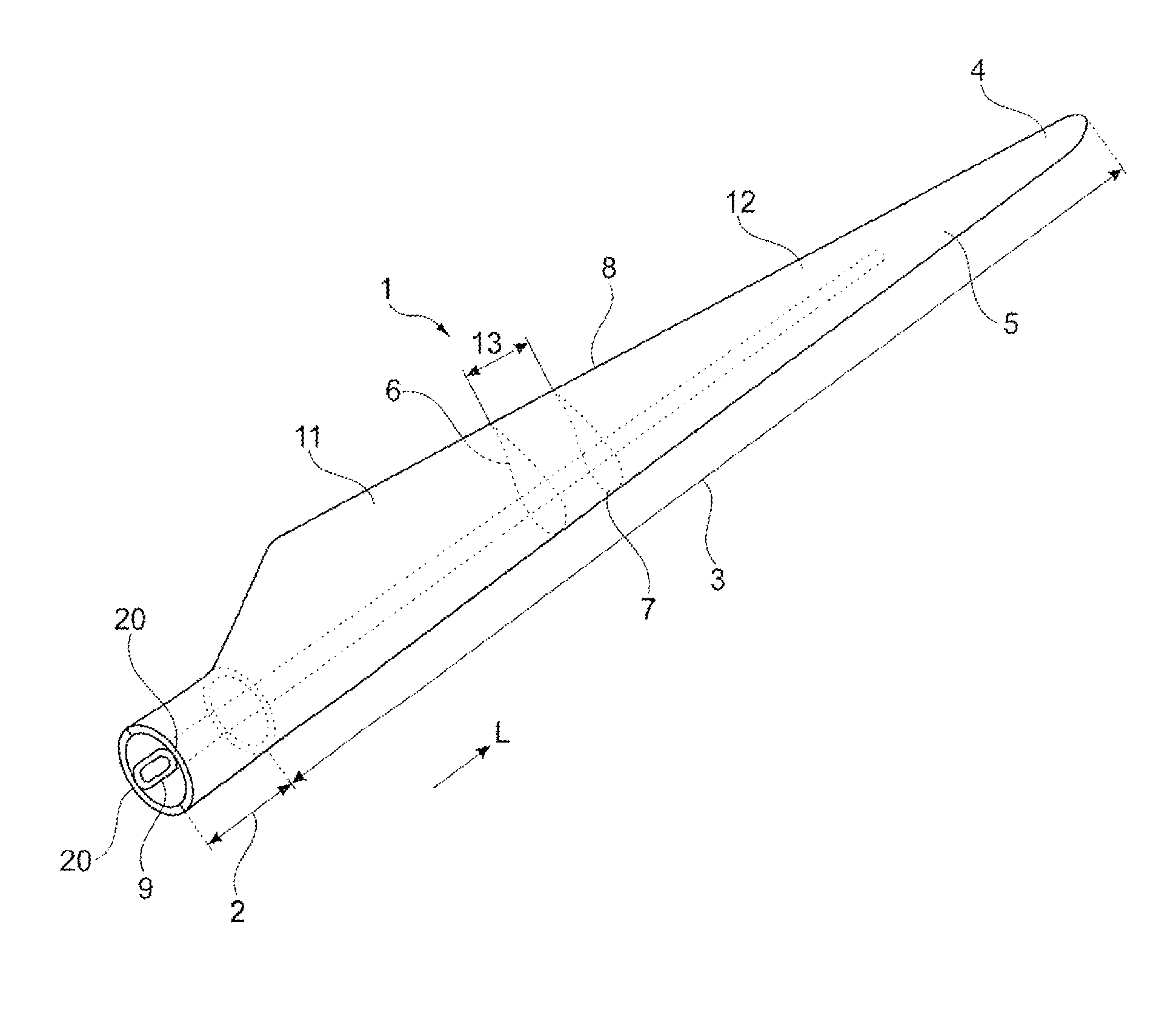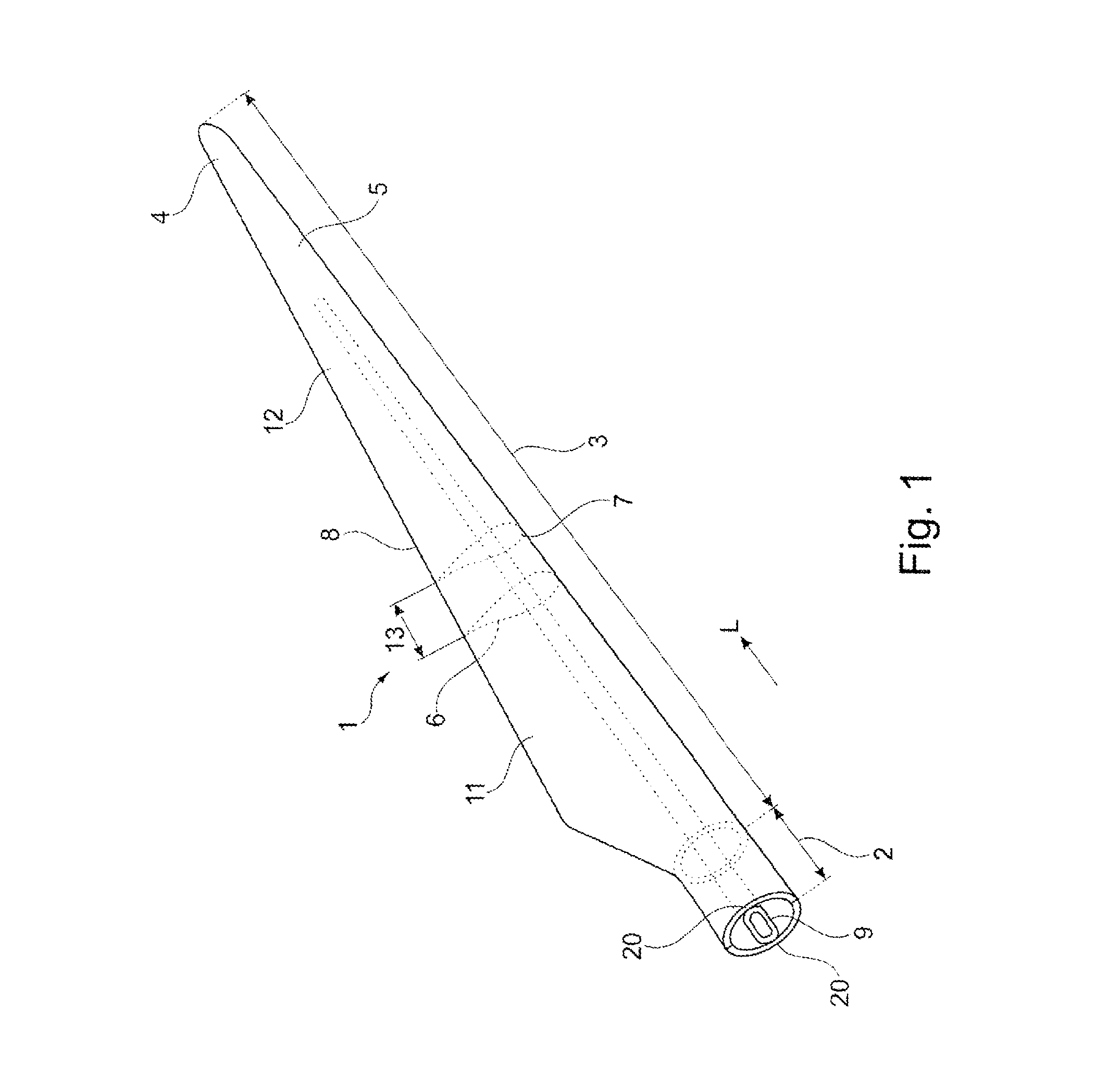Wind turbine blade with transition region
a technology of transition region and wind turbine blade, which is applied in the direction of reaction engine, machine/engine, mechanical apparatus, etc., can solve the problems of increasing the weight of the blade and complicating the layup procedur
- Summary
- Abstract
- Description
- Claims
- Application Information
AI Technical Summary
Benefits of technology
Problems solved by technology
Method used
Image
Examples
first embodiment
[0047]the invention shown in FIG. 2 is a sectional view of a wind turbine blade shell at the transition region. The first region 11 of the blade 1 is reinforced predominantly with the first reinforcement fibre material 21 if form of glass fibres, the first region 11 being shown at the left-hand side of FIG. 2. The second region 12 of the blade 1 is reinforced predominantly with the second reinforcement fibre material 22 in form of carbon fibres 23. The second region 12 is shown at the right-hand side of FIG. 2.
[0048]Fibres or bundles of fibres of the first type 21 extend with differing lengths from the first region 11 into the transition region 13. Correspondingly, fibres or bundles of fibres of the second fibre type 22 extend with differing lengths from the second region 12 into the transition region 13. Further, fibres or bundles of fibres of the third type 23 extend in the transition region 13 between the first and the second type of fibres or bundles of fibres 21, 22 extending f...
fourth embodiment
[0056]FIG. 5A is a diagrammatic view of a fourth embodiment comprising six stacked layer 24 of predominantly the first type of fibres 21, the layers 24 being longitudinally displaced so as to provide a first chamfered boundary surface 18. The embodiment further comprises six stacked layers 25 predominantly of the second type of fibres 22, the layers being longitudinally displaced so as to provide a second chamfered boundary surface 19. Five stacked layers 26 of the third type of fibres 23 are arranged on top of the stacked layers 24 of the first type of the 21 and extend in between the first chamfered boundary surface 18 and the second chamfered boundary surface 19 and onto the lower surface of the stacked layers 25 of the second type of fibres 22. Thereby, a transition region 13 comprising all three types of fibres is provided between the first region 11 comprising predominantly the first type of fibres 21 and the second region 12 comprising predominantly the second type of fibres ...
fifth embodiment
[0058]FIG. 6 discloses for the invention the variation of the three different types of fibres as seen in a longitudinal sectional view. The first region 11 comprises essentially only the first type of fibres 21, such as glass fibres. The transition region 13 comprises a gradually decreasing proportion of the first type of fibres 21 and a gradually increasing proportion of the second type of fibres 22 and additionally an increasing proportion of the third type of fibres 23. The second region 12 comprises predominantly fibres of the second type of fibres 22 and a small amount of fibres of the third type 23. As a result of the shown proportion between the different types of fibres, a smooth transition is provided between the first region 11 comprising only the first type of fibres 21 and the transition region 13 comprising a mixture of the first, the second and the third type of fibres 21, 22, 23. Further, a smooth transition is provided between the transition region 13 comprising a mi...
PUM
| Property | Measurement | Unit |
|---|---|---|
| length | aaaaa | aaaaa |
| length | aaaaa | aaaaa |
| length | aaaaa | aaaaa |
Abstract
Description
Claims
Application Information
 Login to View More
Login to View More - R&D
- Intellectual Property
- Life Sciences
- Materials
- Tech Scout
- Unparalleled Data Quality
- Higher Quality Content
- 60% Fewer Hallucinations
Browse by: Latest US Patents, China's latest patents, Technical Efficacy Thesaurus, Application Domain, Technology Topic, Popular Technical Reports.
© 2025 PatSnap. All rights reserved.Legal|Privacy policy|Modern Slavery Act Transparency Statement|Sitemap|About US| Contact US: help@patsnap.com



